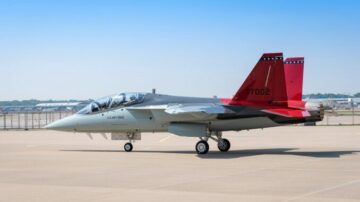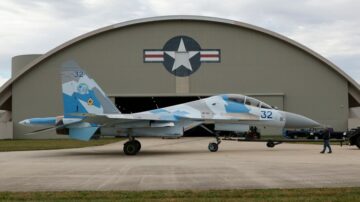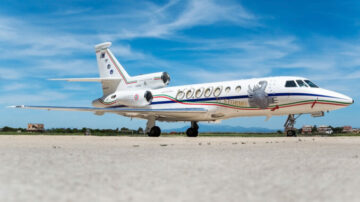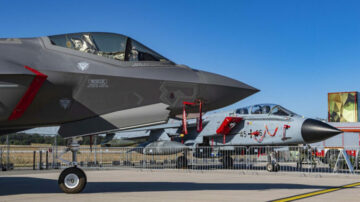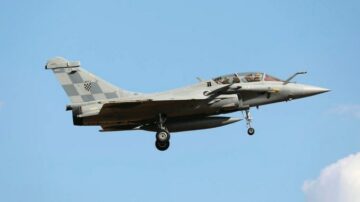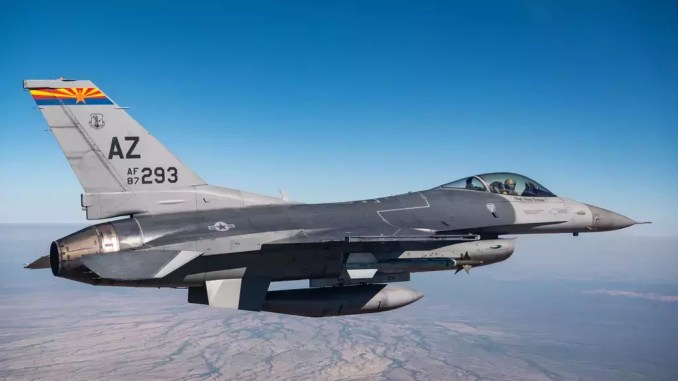
Training will begin in October at Morris Air National Guard Base and will be delivered by the 162nd Wing, which is in charge of training of international F-16 crews.
The Department of Defense announced that the United States will train Ukrainians to fly and maintain F-16 fighters in support of the international effort to develop and strengthen Ukraine’s long-term defenses. “Several pilots and dozens of maintainers” will begin training in October at Morris Air National Guard Base in Tucson, Arizona, facilitated by the Air National Guard’s 162nd Wing.
“The training provided by the United States will complement the F-16 pilot and maintenance training that’s already underway in Europe and further deepens our support of the F-16 training coalition led by Denmark and the Netherlands,” Pentagon Press Secretary Air Force Brig. Gen. Pat Ryder said. “Moving forward we will remain in close consultation with the Danes, the Dutch and other allies to ensure U.S. training complements the broader coalition training efforts.”
Gen. Ryder also added that by announcing the training, the U.S. is preempting any training capacity constraints in Denmark and the Netherlands’ training pipeline to ensure the aircraft are fielded to Ukraine as quickly as possible. In fact, the total number of pilots and maintainers to be trained is not yet known and it will be determined by Ukraine, added Gen. Ryder.
Prior to flight training, the pilots will receive language training at Lackland Air Force Base in San Antonio, Texas beginning in September. Gen. Ryder said that, although some Ukrainian pilots have English language skills, they will require some level of additional English language instruction, given the complexities and the specialized English that’s required to fly the F-16.
“Part of this training will be assessing the individual pilots’ skill level, which will determine help to determine how long that training will last,” clarified Gen. Ryder. “Your basic, new F-16 pilot with not a lot of training on the U.S. side, that training typically lasts about eight months. For a pilot that’s experienced, you’re doing upgrade training, that can range within the five-month range.”
File photo of four RNLAF F-16 Fighting Falcons from Morris Air National Guard Base formerly assigned to the 162nd Wing for international F-16 pilots training. (U.S. Air National Guard photo by Tech. Sgt. George Keck)
” data-medium-file=”https://i0.wp.com/theaviationist.com/wp-content/uploads/2023/08/Ukrainian_F-16_Training_USA_2.jpg?fit=460%2C329&ssl=1″ data-large-file=”https://i0.wp.com/theaviationist.com/wp-content/uploads/2023/08/Ukrainian_F-16_Training_USA_2.jpg?fit=706%2C505&ssl=1″ decoding=”async” class=”size-large wp-image-83221″ src=”https://platoaistream.net/wp-content/uploads/2023/08/the-u-s-will-train-ukrainian-f-16-pilots-and-maintainers-the-aviationist-1.jpg” alt width=”706″ height=”505″ srcset=”https://platoaistream.net/wp-content/uploads/2023/08/the-u-s-will-train-ukrainian-f-16-pilots-and-maintainers-the-aviationist-1.jpg 706w, https://platoaistream.net/wp-content/uploads/2023/08/the-u-s-will-train-ukrainian-f-16-pilots-and-maintainers-the-aviationist-2.jpg 460w, https://platoaistream.net/wp-content/uploads/2023/08/the-u-s-will-train-ukrainian-f-16-pilots-and-maintainers-the-aviationist-3.jpg 128w, https://platoaistream.net/wp-content/uploads/2023/08/the-u-s-will-train-ukrainian-f-16-pilots-and-maintainers-the-aviationist-4.jpg 768w, https://i0.wp.com/theaviationist.com/wp-content/uploads/2023/08/Ukrainian_F-16_Training_USA_2.jpg?w=1024&ssl=1 1024w” sizes=”(max-width: 706px) 100vw, 706px” data-recalc-dims=”1″>
During the press briefing, the General further explained that the delivery of the F-16s, just like the training, is a process that requires months, not weeks, even if the US government is already expediting the third party transfer requests and the related consultations with the Congress. Also, let’s keep in mind that the adoption of a new fighter jet by an air force is a long and complex process that usually takes years.
The coalition is doing its best to accomplish this in few months to help Ukraine to build long-term capabilities. However, there is not only the delivery of the aircraft and the training of pilots and maintainers to be done, infrastructures and ground equipment are also needed to give the Ukrainians the ability to control and sustain the F-16 from Ukrainian airfields.
“Obviously, we’re going to work as fast as we can. But what you don’t want to do is you don’t want to rush a pilot and train them in a high-performance combat aircraft and then put them in harm’s way not fully prepared,” said Gen. Ryder. “So a lot of this will depend on the pilots where they’re at in experience, the training, and making sure that again, that we’re providing the right pilots with the right aircraft, at the right time to be able to be effective at the end of the day in combat.”
As a side note, Major Andrii Pilshchykov, a famous Ukrainian Air Force pilot better known as “Juice” who was killed in the collision of three L-39s on Aug. 25, 2023, was among those who had travelled to the U.S. in June 2022 to urge lawmakers to support Ukraine with aircraft and training. They described their combat sorties, flying outdated MiG-29s against the latest Russian fighter jets, as “suicide missions” and said that Russian pilots changed their tactics to better counter to the ones used by the Ukrainian Air Force.
Along with another pilot, “Moonfish”, “Juice” also asked for F-16s during their visit to Washington, mentioning that Ukrainian pilots were eager to start training on the F-16 and were taking English lessons in their free time to get ready for this. They said one of the reasons the F-16 was being requested is its Suppression of Enemy Air Defenses capabilities. Unfortunately, “Juice” won’t be able to see the request being fulfilled.
- SEO Powered Content & PR Distribution. Get Amplified Today.
- PlatoData.Network Vertical Generative Ai. Empower Yourself. Access Here.
- PlatoAiStream. Web3 Intelligence. Knowledge Amplified. Access Here.
- PlatoESG. Automotive / EVs, Carbon, CleanTech, Energy, Environment, Solar, Waste Management. Access Here.
- PlatoHealth. Biotech and Clinical Trials Intelligence. Access Here.
- ChartPrime. Elevate your Trading Game with ChartPrime. Access Here.
- BlockOffsets. Modernizing Environmental Offset Ownership. Access Here.
- Source: https://theaviationist.com/2023/08/28/ukrainian-f-16-training/?utm_source=rss&utm_medium=rss&utm_campaign=ukrainian-f-16-training
- :is
- :not
- :where
- 1
- 125
- 25
- a
- ability
- Able
- About
- accomplish
- Achieve
- added
- Additional
- Adoption
- Aerospace
- aerospace engineering
- again
- AIR
- Air Force
- aircraft
- already
- also
- Although
- among
- an
- and
- ANG
- announced
- Announcing
- Another
- any
- applied
- ARE
- areas
- arizona
- AS
- asked
- Assessing
- assigned
- At
- Aug
- avatar
- base
- based
- basic
- BE
- begin
- Beginning
- being
- BEST
- Better
- Briefing
- broader
- build
- but
- by
- CAN
- capabilities
- Capacity
- changed
- charge
- clarified
- Close
- coalition
- combat
- Complement
- complex
- complexities
- conflicts
- Congress
- constraints
- consultation
- consultations
- contributor
- control
- Counter
- Current
- day
- deepens
- Defense
- Degree
- delivered
- delivery
- Denmark
- Department
- department of defense
- described
- Determine
- determined
- develop
- do
- doing
- done
- Dont
- dozens
- during
- Dutch
- e
- eager
- Effective
- effort
- efforts
- eight
- Electronic
- end
- Engineering
- English
- ensure
- equipment
- Ether (ETH)
- Europe
- Even
- experience
- experienced
- expertise
- facilitated
- fact
- famous
- FAST
- few
- fighters
- fighting
- flight
- flying
- For
- Force
- formerly
- Forward
- four
- Free
- freelance
- from
- fully
- further
- Gen
- General
- George
- get
- Give
- given
- going
- Government
- graduate
- Ground
- Guard
- had
- Hampton
- Have
- he
- help
- high-performance
- his
- Home
- How
- However
- HTTPS
- if
- in
- individual
- infrastructures
- International
- IT
- Italy
- ITS
- journalist
- jpg
- june
- just
- Keep
- known
- language
- Last
- Last Year
- latest
- lawmakers
- Led
- Lessons
- Level
- like
- Long
- long-term
- Lot
- maintain
- maintenance
- major
- Making
- master
- max-width
- Military
- mind
- Mission
- months
- National
- needed
- Netherlands
- New
- note
- number
- october
- of
- on
- ONE
- ones
- only
- Operations
- osint
- Other
- our
- party
- pentagon
- photo
- pilot
- Pilots
- pipeline
- plato
- Plato Data Intelligence
- PlatoData
- possible
- premier
- prepared
- press
- process
- provided
- providing
- put
- quickly
- range
- ready
- reasons
- receive
- related
- remain
- request
- requested
- requests
- require
- required
- requires
- right
- rush
- russian
- s
- Said
- San
- secretary
- see
- September
- side
- skill
- skills
- some
- specialized
- start
- States
- Strengthen
- Studying
- support
- sure
- tactics
- takes
- taking
- tech
- techniques
- texas
- that
- The
- the Netherlands
- the world
- their
- Them
- then
- There.
- they
- Third
- this
- three
- time
- to
- Total
- Train
- trained
- Training
- transfer
- typically
- u.s.
- Ukraine
- Ukraines
- Ukrainian
- Ukrainians
- Underway
- unfortunately
- unit
- United
- United States
- upgrade
- us
- us government
- used
- usually
- Visit
- want
- was
- washington
- Way..
- we
- Weeks
- were
- What
- which
- WHO
- will
- Wing
- with
- within
- Work
- world
- year
- years
- yet
- you
- zephyrnet


